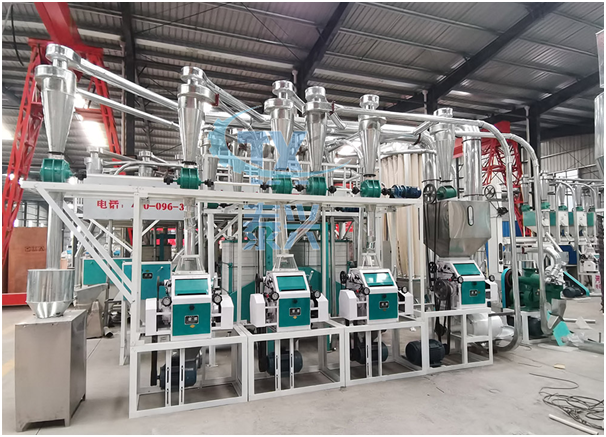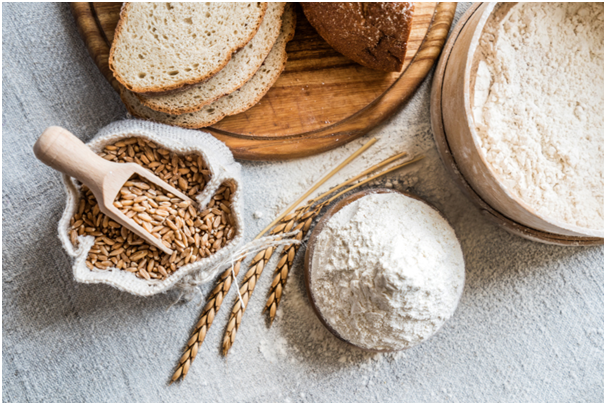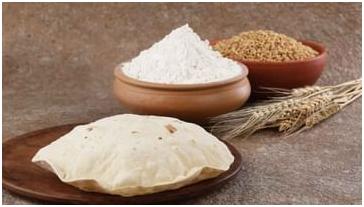Written by : Samrudh Srinath
Introduction
Predicting the Food and Beverage industry’s future is difficult, especially after a terrible pandemic flipped the industry upside down. However, there are a few major takeaways from the last year that are likely to have an impact in 2022 and beyond. Our Food Processing sector must keep up with the latest innovations as it is critical to adapt to new technologies to keep in sync with changing perspectives and consumer behavior. This has become even more essential in light of the surge in demand for packaged foods and beverages as a result of protracted home closures due to the pandemic.
So, what exactly does the Food and Beverage industry have in store for the future? We’ll go over some of the major trends in this blog, ranging from emerging technologies in the Food and Beverage industry to highlighting consumers’ expectations today.
1. Migration from sugar, oily and maida-based products to healthy alternatives

The industry is seeing a shift away from regular sugar and maida consumption as well as finding new ways to circumvent it. There are several reasons for this, such as obesity and extra belly fat, both of which are risk factors for diabetes and heart disease, are often related to consuming a lot of refined sugar. High sodium foods have been linked to heart failure and heart attacks, kidney problems, fluid retention, stroke, and osteoporosis, whereas foods made from maida have a high glycemic index.
Many new developments and revivals of age-old customs are gaining popularity as ways to avoid using them. For example, instead of refined sugar, a large percentage of the enlightened population has begun to use jaggery, stevia, and other sweeteners. Whole wheat flour, oat flour, and other flours are great alternatives to maida. Even commercial food producers are adapting and changing their marketing strategies to keep up with this new trend.
Oil is another essential consideration. Deep-fried, oily, and greasy foods are unhealthy, and they can lead to obesity, joint pain, breast and ovarian cancer, strokes, diabetes, hypertension, and heart attacks, among others.
There are a few ways to reduce oil consumption:
• Instead of frying, try roasting, baking, grilling, or steaming your meal.
• When cooking, use a teaspoon to ensure that you are using a consistent and precise amount of oil.
• Use a blend of oils in moderation to receive all the required fatty acids. Sunflower oil, coconut oil, flaxseed oil, peanut oil, rice bran oil, mustard oil, and sesame oil are some of the oils you can use.
Many sugar-free, oil-free, and whole wheat/millet-based recipes are becoming increasingly popular, and marketers are exploring new production methods to meet this demand. As a result, in order to meet this shifting demand, the food industry must adapt and update.
2. Fitness trends

There is a growing trend towards fitness and maintaining a healthy lifestyle. Fitness is more often than not misinterpreted as bodybuilding, but fitness at its core means maintaining a healthy mind and body. Either way, the masses are moving toward fitness and health, and this directly affects the food industry.
A rule of thumb in fitness is more protein, fewer carbs. There is a growing demand for high-protein, high-fiber, and low-calorie snack and meal options. We see multiple startups offering healthy and/or high-protein food and beverage options.
One thing is certain: Indians desire to enjoy a healthier lifestyle. The most popular diets and exercise regimens right now are those that encourage optimal nutrition, recuperation, and sickness and injury avoidance. Whole-health diets, back-to-basics food and exercise regimens, exotic culinary influences, functional fitness, mind/body exercises, and the “buddy system” of working out are among the health trends on the rise. As a result, the food business must keep up and offer healthier, more protein-dense, whole meals. This applies not just to food production but also to food preparation, as well as to techniques, the environment, and service facilities.
Another important development is the introduction of healthy snacks such as vacuum-fried and freeze-dried snacks by several start-ups in India. To preserve the optimum nutrients, original flavor, and original shape of the food, companies use vacuum frying or freeze-drying techniques.
3. Increasing consumer awareness and demand for organic products
 People nowadays are aware that agriculture is one of the least regulated industries. Some farmers, for example, employ a lot of insecticides and chemical fertilizers to protect their produce from insects and improve productivity per acre. These chemicals are harming the bio-cycle, and humans are already feeling the effects of unintentional chemical overuse. Overexposure to chemicals is connected to a wide range of dangerous illnesses. Organic foods provide a long-term answer to this issue. In India, the organic food business is still in its infancy, although it is rapidly increasing. In the coming years, organic foods will inevitably become the standard.
People nowadays are aware that agriculture is one of the least regulated industries. Some farmers, for example, employ a lot of insecticides and chemical fertilizers to protect their produce from insects and improve productivity per acre. These chemicals are harming the bio-cycle, and humans are already feeling the effects of unintentional chemical overuse. Overexposure to chemicals is connected to a wide range of dangerous illnesses. Organic foods provide a long-term answer to this issue. In India, the organic food business is still in its infancy, although it is rapidly increasing. In the coming years, organic foods will inevitably become the standard.
Most conventional grocery stores now have organic food items prominently displayed in their produce and dairy shelves. Organic food has also become increasingly popular among a wider group of consumers. Today, organic handlers are selling more organic products to conventional shops and club stores than ever before. Organic farms, on the other hand, have struggled to keep up with demand at times, resulting in periodic organic food shortages.
It’s worth noting that organic food is more expensive than conventional produce. This difference may appear small and insignificant in consumer quantities, but switching totally to organic products will be significant for businesses. This is why, even though the demand for typical produce has reduced, it continues to thrive.
4. Role of technology, frozen and instant or ready-to-cook/eat foods and beverages

Demands for food and beverages with improved nutritional value, sustainability, or ethical impact are being met via technology. The most significant trends in the country are frozen, instant or ready-to-eat foods, and high-pressure processing (HPP).
The frozen food business in India has been booming for some time now, thanks to the rising demand for natural products. Individual Quick Freeze (IQF) is a superior freezing method that has been introduced by a few Indian enterprises. Instead of blocking freezing, which causes larger ice crystals to damage product quality, IQF is a quick freezing technique. Individual pieces of fruits and vegetables, meat, and seafood products that are swiftly frozen, preventing larger ice crystals from forming, are referred to as IQF foods.
Instant and precooked food items have very good scope, as the younger generation has little or no knowledge of preparing home-cooked foods. To accommodate this demand, more companies are developing and creating instant food options.
HPP is a method of killing hazardous bacteria by applying intense pressure. HPP technology helps to preserve the food product’s taste, appearance, and nutritional content. Pressure technology is best suited for high-moisture liquids and solid foods. HPPs are commonly used in the food sector to preserve fruit and vegetable products such as jams, purees, juices, meats, and fish. However, HPP is only used in a few items in India, such as fruit and vegetable juices and ready-to-eat meals.
To meet consumer expectations, food makers must keep up with technological developments and tap into the industry’s experience, particularly when it comes to solving the obstacles of making great-tasting healthy foods.
5. Sustainable production and marketing and transparency
 Despite the general public’s lack of awareness of the SDGs, many customers are becoming more interested in sustainable and ethically sourced food and drink items, and manufacturers are responding. Some of the important trends that are impacting product development — and, as a result, the ingredients sector — include sustainability. For example, many people believe that organically grown food is healthier for the environment, and awareness of the livestock sector’s disproportionately large CO2 emissions is fuelling interest in alternative protein sources such as pulses and insects, as well as the trend toward meat-free diets.
Despite the general public’s lack of awareness of the SDGs, many customers are becoming more interested in sustainable and ethically sourced food and drink items, and manufacturers are responding. Some of the important trends that are impacting product development — and, as a result, the ingredients sector — include sustainability. For example, many people believe that organically grown food is healthier for the environment, and awareness of the livestock sector’s disproportionately large CO2 emissions is fuelling interest in alternative protein sources such as pulses and insects, as well as the trend toward meat-free diets.
A few initiatives and regulations to improve sustainability in the food industry:
- National Innovations in Climate Resilient Agriculture (NICRA)
- Planting trees under NBM, BGREI, SMAF and NFSM schemes
- Climate change program, Government of India.
- Agricultural production policy, Government of India.
- Ethical Trading Initiative
6. Slow but steady rise in advocacy of plant-based diet/veganism

By now, everyone in the trade is aware of the expanding plant-based diet trend and the rising demand for plant-forward products. Plant-based eating has become more mainstream, resulting in rapid expansion in new market segments, particularly when it comes to alternative proteins and indulgence.
In fact, compared with the previous year, the average yearly growth in plant-based foods and beverages has grown at a rapid pace. A lot of consumers prefer plant-based alternatives because they believe they taste better. This creates a huge opportunity for brands that choose to work with ingredient firms that specialise in flavour solutions for plant-based applications. Well-known brands are beginning to provide vegan versions of their products, with several major releases in 2021. In a few markets, McDonald’s has introduced the McPlant line. Plant-based meat firms are sprouting up all over the place, and they’re becoming increasingly popular. PETA (People for the Ethical Treatment of Animals) is also a major advocate for veganism, which is gaining a lot of traction among the general public.
The development of the plant-based lifestyle has been helped by social media. Celebrities who do not consume animal products include Ariana Grande, Miley Cyrus, and Ellen DeGeneres, and the hashtag #vegan has more than 90 million posts on Instagram.
The main reasons for eating less meat or becoming vegan are; health, weight loss, animal welfare, the environment, antibiotic concerns, and flavor.
Conclusion
Due to growing consumer awareness, it is now more important than ever that companies comply with safety standards and government regulations and also effectively communicate with the consumers about said compliance. FSSAI (Food Safety and Standards Authority of India) is the food regulatory body in India. It begins the process of aligning India’s food legislation with foreign norms. The FSSAI is a national regulatory body tasked with developing science-based food standards and regulating and monitoring the manufacture, processing, storage, distribution, sale, and import of food in order to ensure the availability of safe and wholesome food for human consumption















 Source:
Source: 
 Source:
Source: Source:
Source:  Source:
Source:


 People nowadays are aware that agriculture is one of the least regulated industries. Some farmers, for example, employ a lot of insecticides and chemical fertilizers to protect their produce from insects and improve productivity per acre. These chemicals are harming the bio-cycle, and humans are already feeling the effects of unintentional chemical overuse. Overexposure to chemicals is connected to a wide range of dangerous illnesses. Organic foods provide a long-term answer to this issue. In India, the organic food business is still in its infancy, although it is rapidly increasing. In the coming years, organic foods will inevitably become the standard.
People nowadays are aware that agriculture is one of the least regulated industries. Some farmers, for example, employ a lot of insecticides and chemical fertilizers to protect their produce from insects and improve productivity per acre. These chemicals are harming the bio-cycle, and humans are already feeling the effects of unintentional chemical overuse. Overexposure to chemicals is connected to a wide range of dangerous illnesses. Organic foods provide a long-term answer to this issue. In India, the organic food business is still in its infancy, although it is rapidly increasing. In the coming years, organic foods will inevitably become the standard.
 Despite the general public’s lack of awareness of the SDGs, many customers are becoming more interested in sustainable and ethically sourced food and drink items, and manufacturers are responding. Some of the important trends that are impacting product development — and, as a result, the ingredients sector — include sustainability. For example, many people believe that organically grown food is healthier for the environment, and awareness of the livestock sector’s disproportionately large CO2 emissions is fuelling interest in alternative protein sources such as pulses and insects, as well as the trend toward meat-free diets.
Despite the general public’s lack of awareness of the SDGs, many customers are becoming more interested in sustainable and ethically sourced food and drink items, and manufacturers are responding. Some of the important trends that are impacting product development — and, as a result, the ingredients sector — include sustainability. For example, many people believe that organically grown food is healthier for the environment, and awareness of the livestock sector’s disproportionately large CO2 emissions is fuelling interest in alternative protein sources such as pulses and insects, as well as the trend toward meat-free diets.


